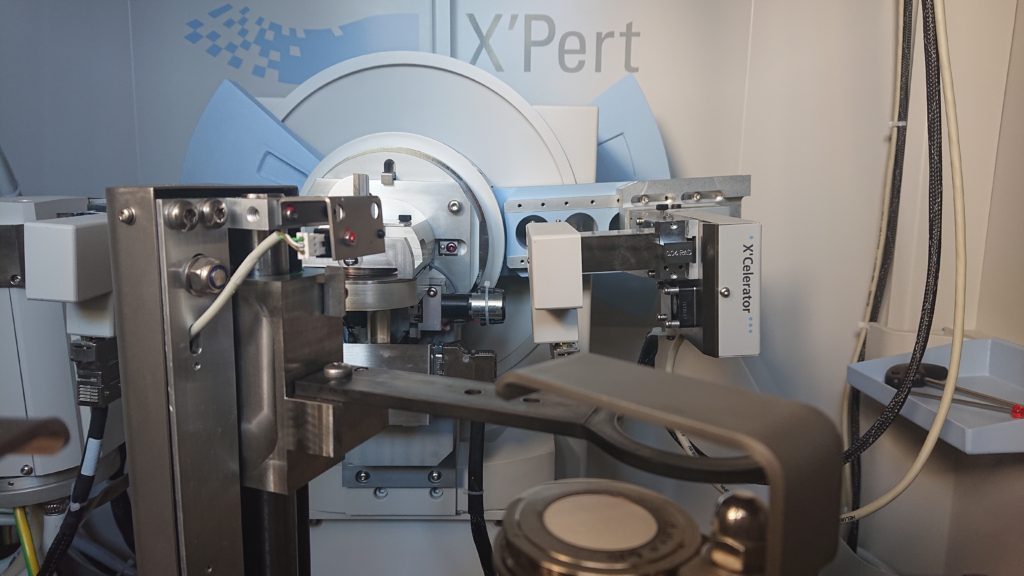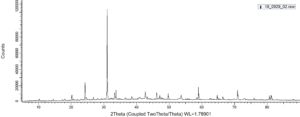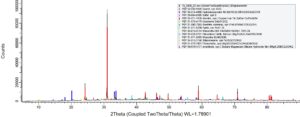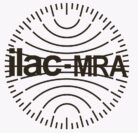
.. X-ray Diffraction (XRD) is a technique that is utilized to identify crystalline phases present in a given sample.
For powder diffraction, a micronized sample is pressed into a specialised holder and placed into the X-ray Diffractometer. The instrument bombards the powdered sample with X-rays at varying angles. As the X-rays come into contact with the particulate material, they are diffracted by the crystal structure of the phase or phases that are being analysed. The scan results in a diffraction pattern which contains numerous peaks or humps.
Figure 1: Raw scan yet to be interpreted
The resulting peaks or humps are similar to a fingerprint, as they can be matched to specific mineral or crystalline phases. The interpretation of the diffraction pattern is a comparative method where the data is matched to an exhaustive list of reference patterns. By using this interpretation technique, it is possible to identify well over ten different minerals or crystalline phases within an unknown sample, as long as they are present in concentrations that exceed ~1%.
Figure 2: Interpreted scan
Note that elemental composition is not determined by XRD, but can be inferred from the phases identified. Confidence in matching the phases can vary depending on how closely the standardised database pattern match the minerals present in the sample, the number and type of other phases present in the sample, crystallinity, concentration of the individual phases and the quality of the diffraction pattern as well as the grinding/micronizing process itself.
Other information than can be gleaned from a diffraction pattern includes the degree of weathering or alteration, crystallite size, elemental substitution, the degree of disorder, and the amorphous content.
The use of elemental assay information (say from XRF) , sample history and geology/location information and complimentary techniques all assist by strengthening confidence in making phase identification more accurate.
Quantification XRD techniques vary from qualitative (what is present) to semi quantitative (what and relative abundance of what is present) through to fully Quantitative Rietveld analysis.
One of the most challenging areas for phase identification is clay speciation. Due to the poor crystallinity and irregular orderingof some clay groups, identification may require additional sample preparation methods including glycolation, heat (dehydration) and other techniques.
At Microanalysis we have several automated powder X-ray Diffractometers. Utilising a number of diffraction databases including the latest 2019 complete International Centre for Diffraction Database (ICDD) to assist in the accurate analysis of unknown samples. We have a myriad of different holding mounts to assist in the analysis of the samples including our standard holders that utilise approximately one cubic centimetre of powdered sample, holders that take milligram quantities of sample, holders that can present filter cloth, flat ceramic or metallic plates and holders that can accommodate some sample irregularity.
The techniques we frequently utilise are:
- Qualitative XRD where the phase identification is conducted and the minerals are classified as major, minor and trace;
- Semi-quantitativein which the phase identification includes a concentration which is calculated using the normalized reference intensity ratio method where the intensity of the 100% (highest) peak divided by the published correction factor for each mineral phase is summed and the relative percentages of each phase calculated based on the relative contribution to the sum. An estimation of the total amorphous content can also be given. The mineral concentrations are reported as percentages, with the total being normalised to 100%. XRF assay data can be used to infer absolute phase concentration;
- Spiked semi-quantitative is similar to a standard semi-quantitative analysis with a higher confidence in the concentration values and a more accurate measurement of the amorphous content;
- Quantitative XRD analysis using an internal standard, with full Rietveld analysis to give the highest confidence possible in the concentration of phases and amorphous content determined. This technique considers preferred orientation, crystallite size, and strain within the crystal lattice;
- Crystalline silica determinations for alpha quartz, cristobalite and tridymite utilise a full phase identification to check for overlaps that may be present from the phases present. A specific peak scan is then performed with this result compared against a five point calibration curve to produce a value of each crystalline silica phase present;
- Clay speciation utilising a semi-quantitative analysis followed by gylcolation and heating to identify specific clay groups;
- Respirable free silica (crystalline) determination in which a semi-quantitative analysis is performed on the bulk or respirable (PM4/PM2.5) fraction and is combined with particle size determination and the respirable particulates/aggregates checked using scanning electron microscopy;
- Comparative XRD is utilised if there is no entry in the databases for the compound being examined but a suitable reference pattern can be constructed computationally or has been provided;
- Specific mineral semi-quantitative analysis utilises solvent washing, heavy liquid separation, magnetic separation and other specific techniques to concentrate the phases of interest and provide increased confidence in the identification of minerals and to enhance XRD features; and
- Certain polymers, organics and highly disordered compounds still exhibit short range order than can diffract to give a ‘fingerprint’ unique to the intrinsic bond structure. Non-traditional materials (other than minerals) may still be amenable to XRD analysis and confirmation of composition.
Microanalysis Australia is always pleased to customise XRD techniques to accommodation specific client requirements and achieve the highest quality results.








